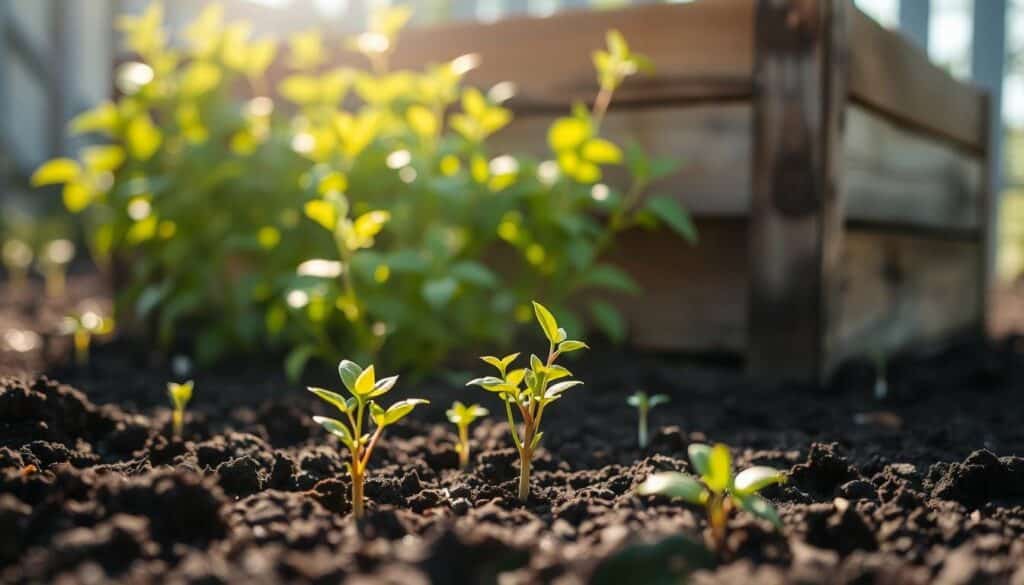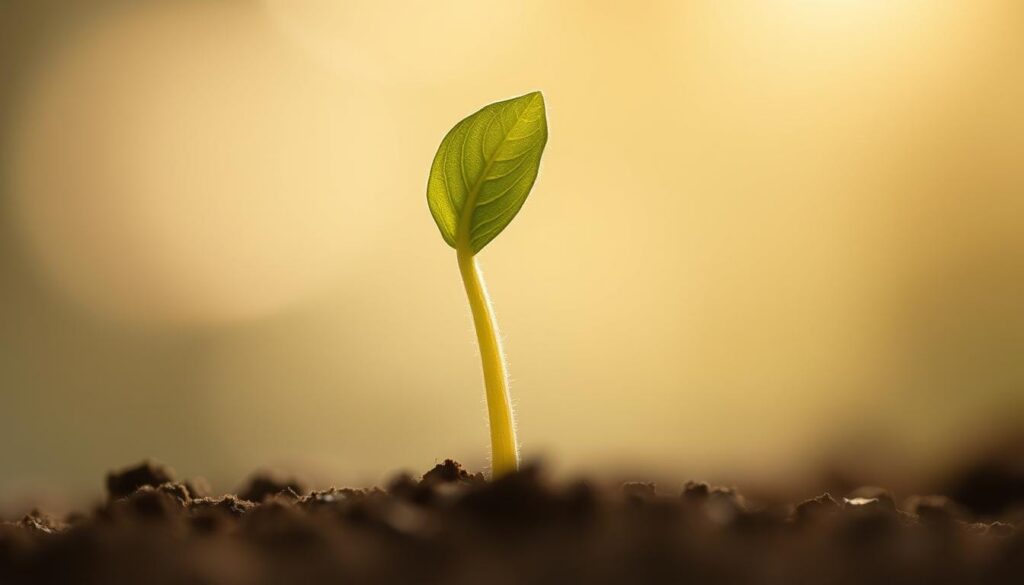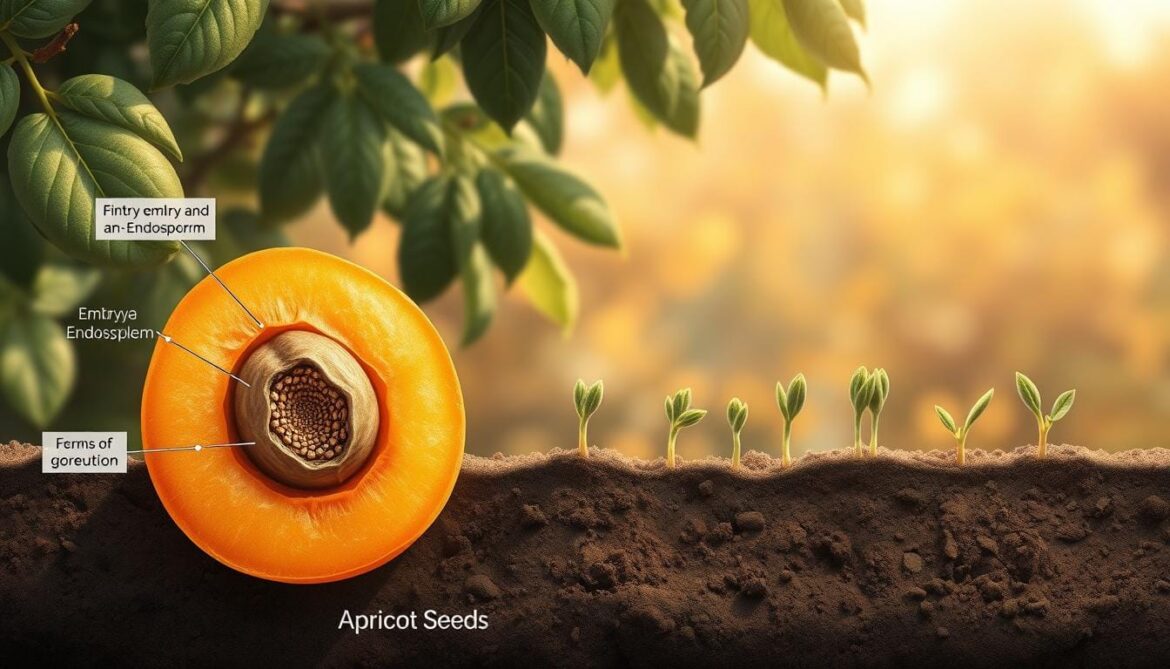Growing apricot trees from seeds is a magical journey. It connects us with nature’s wonders. For us, learning to germinate apricot seeds is more than a skill. It’s a journey that fills us with joy and connects us to the earth.
This guide will help you through the process of germinating apricot seeds. It’s perfect for both new and seasoned gardeners. Whether you want to grow your own apricots or learn about plant growth, we’ve got you covered.
Apricot trees do well in zones 5 to 8, making them easy to grow in many places. With a little patience and care, you can grow a tree that will give you delicious apricots for years.
Key Takeaways
- Learn the complete process of how to germinate apricot seeds
- Understand the critical stages of apricot seed germination
- Discover the ideal conditions for successful seed propagation
- Master techniques that ensure healthy seedling development
- Explore the rewarding journey of growing apricot trees from scratch
Understanding Apricot Seeds
Exploring how to grow apricots from seed is a fascinating journey. It’s a chance for gardeners to grow their own fruit trees from scratch. This connects them to the plant’s life cycle.
Apricot seeds are more than just kernels inside the fruit’s pit. Each seed has the chance to grow into a full-sized fruit tree. But, it takes patience and careful attention.
Anatomy of Apricot Seeds
The seeds are in a hard shell, with a single kernel inside. They have unique traits that make growing apricots from seed both challenging and rewarding.
- Contains a single seed per pit
- Requires specific stratification conditions
- Potential toxicity if consumed in large quantities
Benefits of Seed Propagation
Our apricot seed propagation journey has many benefits:
| Benefit | Description |
|---|---|
| Cost-Effective | Grow trees from existing fruit pits |
| Genetic Diversity | Each seed potentially produces unique tree characteristics |
| Learning Experience | Gain hands-on gardening knowledge |
Note: Apricot seeds contain cyanogenic compounds and should be handled with care, avoiding consumption in large quantities.
When to Start Germinating
Timing is key when starting apricot seeds. Knowing the right conditions and seasons is essential. Our guide will show you the best ways to start apricot seeds for growth.
Ideal Seasons for Germination
The best times for planting apricot seeds are in two main periods:
- Autumn: When the soil starts to cool down
- Early Spring: Right after the last frost
Key Factors Influencing Germination Timing
Several important factors affect starting apricot seeds:
- Temperature Range: Seeds need 32°F to 45°F for germination
- USDA Hardiness Zones: Best in zones 5-9
- Seed Selection: Choose mid to late-season varieties
Our research shows that picking the right time can boost your success. Seeds from early apricots may not sprout well. So, be patient and plan carefully for planting.
Germination Timeline
Here’s what you can expect during germination:
- Seed soaking: Soak overnight in room-temperature water
- Cold stratification: 4-6 weeks
- Sprouting period: 1-2 months
By knowing these timing tips, you’ll increase your chances of growing healthy apricot trees.
Preparing Apricot Seeds for Germination
Starting with apricot pit germination requires careful seed preparation. Our guide will help you choose the best seeds and prepare them for growth. Learning about apricot seed stratification is key for gardeners wanting to grow these fruit trees.
Selecting Healthy Seeds
When picking apricot seeds, look for quality and life. Choose seeds from ripe, fresh fruits with these traits:
- Plump and undamaged kernels
- No signs of mold or discoloration
- Harvested from local, disease-free trees
Cleaning and Drying the Seeds
Seed preparation is detailed. Follow these steps for apricot pit germination:
- Crack open the apricot pit carefully using a nutcracker
- Gently extract the kernel without damaging it
- Rinse seeds thoroughly with cool water
- Pat dry using a clean paper towel
- Spread seeds on a flat surface to air dry completely
Our research shows cold stratification is vital for apricot seed germination. Refrigerating seeds for 30-60 days boosts sprouting success. Gardeners can expect a 30-50% germination rate with proper preparation.
Stratification Process for Apricot Seeds
Apricot seed germination needs a special technique called stratification. This process imitates winter conditions, helping seeds break dormancy and sprout successfully.
Understanding Seed Stratification
Stratification is key for apricot seed germination. Most perennial seeds need cold treatment to germinate. This involves cold, moist conditions that mimic winter.
Cold Stratification Methods
- Refrigeration method
- Cold water soaking
- Winter sowing
- Outdoor treatment
Apricot Seed Stratification Technique
Here’s how to stratify apricot seeds:
- Get fresh, ripe apricot seeds
- Clean the seeds well
- Put seeds in a moist container with sand or peat moss
- Keep it in the fridge at 32-45°F (0-7°C)
Stratification Duration
Apricot seeds need 6-8 weeks of cold stratification. This breaks dormancy and prepares them for germination. After stratification, they sprout in 1-3 months, depending on the variety.
| Stratification Parameter | Recommended Conditions |
|---|---|
| Temperature Range | 32-45°F (0-7°C) |
| Duration | 6-8 weeks |
| Moisture Level | Consistently moist but not waterlogged |
| Germination Timeframe | 1-3 months after stratification |
Pro tip: Start your apricot seed stratification about 4 months before the last expected frost date in your region for optimal results.
Choosing the Right Soil
Starting with the right soil is key to growing apricot seeds. The soil you pick can make a big difference. Our garden experts know that good soil is essential for healthy plants.
For apricot seed planting, we recommend a special soil mix. It should support good germination and growth. The best soil has:
- Well-draining sandy loam texture
- pH range between 6.5 to 7.5
- Rich in organic matter
- Loose and easily workable structure
Recommended Soil Types
For growing apricots from seed, we suggest a custom soil mix. It should drain well and hold nutrients. A good mix includes:
- 60% sandy soil
- 20% compost
- 20% perlite or vermiculite
Drainage: The Critical Factor
Proper drainage is non-negotiable for apricot seed cultivation. Waterlogged soil can harm seedlings. Our method keeps the soil moist but not too wet, perfect for roots.
“The secret to successful apricot seed germination lies in understanding soil dynamics.” – Agricultural Gardening Experts
By choosing and preparing your soil well, you’ll get strong apricot seedlings. They have a great chance of growing well and giving you tasty fruit.
Planting Germinated Seeds
Starting apricot seed propagation needs careful planting techniques. After stratification, ensure a great start in their new home.

Selecting the Right Planting Container
Choose containers that give roots room to grow. A 15-inch pot is ideal for apricot seeds. Make sure they drain well to avoid waterlogging.
Correct Planting Depth
Planting depth is key for seed germination. Here’s how to plant apricot seeds:
- Plant seeds 1-2 inches deep in rich soil
- Make a hole with your finger or a dibber
- Put the seed horizontally for proper sprouting
Spacing Seeds Appropriately
Spacing is vital for apricot seed growth. Follow these spacing tips:
- Space seeds 3-4 inches apart in the pot
- Give each seed room for roots and shoots
- Use organic potting mix for best growth
Apricot seed germination takes 4 to 6 weeks. Patience is key during this delicate stage of growth.
Watering Techniques for Apricot Seeds
Apricot seedling care needs a balance of moisture and precision. Water is key to germinating apricot seeds and keeping young plants healthy.
Keeping apricot seeds and seedlings hydrated is essential. Our guide will show you how to keep your plants thriving.
Importance of Moisture
Moisture is vital for seed germination. Apricot seeds need consistent, gentle watering to sprout. Here are some moisture tips:
- Maintain soil moisture without waterlogging
- Use lukewarm water for gentle hydration
- Avoid direct water streams that might displace seeds
How Often to Water
Watering frequency for apricot seedlings varies. Knowing these factors helps create a strong care routine.
| Growing Condition | Watering Frequency | Moisture Level |
|---|---|---|
| Indoor Seedlings | Every 2-3 days | Consistently moist |
| Outdoor Seedlings | 1-2 times per week | Depends on rainfall |
| Hot Climate | 2-3 times per week | More frequent checking |
| Cold Regions | Once per week | Less evaporation |
Remember, consistent moisture is key. The soil should be damp but not too wet. Check soil moisture with your finger before watering to avoid over or under watering.
Light Requirements for Seedlings
Growing apricots from seed needs careful light attention. Apricot seedling care focuses on sunlight’s role in healthy growth. Our guide will show you the light needs for strong apricot seedlings.
Ideal Light Conditions for Growth
Apricot trees love lots of sunlight. They need 6-8 hours of direct sun a day for strong roots and fruit. Growing apricots from seed means mimicking natural light for success.
- Position seedlings in a bright location
- Ensure consistent light exposure
- Protect young plants from intense midday heat
Using Artificial Lighting Effectively
Indoor gardeners can grow apricot seedlings with grow lights. These lights mimic natural sunlight when it’s hard outside. For best results, keep grow lights on for 6-8 hours a day, about 12 inches from the seedlings.

- Use full-spectrum grow lights
- Maintain consistent light distance
- Monitor seedling response to light intensity
Tip: Gradually expose seedlings to increasing sunlight before transplanting to help them acclimate to outdoor conditions.
Caring for Germinated Apricot Plants
Taking care of your new apricot seedlings is key. After you’ve grown apricot seeds, your young plants need special care to grow into strong trees.
This guide will show you how to support your apricot plants in their early growth stages.
Fertilizing New Seedlings
Feeding your apricot seedlings right is important. Here’s how to fertilize them gently:
- Use a balanced, low-nitrogen fertilizer
- Apply fertilizer sparingly to avoid root burn
- Wait until seedlings reach 6 inches in height
- Dilute fertilizer to half strength for young plants
Protecting from Pests and Diseases
Keeping your apricot seedlings safe from pests and diseases is vital.
| Pest/Disease | Prevention Strategy | Treatment |
|---|---|---|
| Aphids | Neem oil spray | Insecticidal soap |
| Root Rot | Ensure proper drainage | Reduce watering frequency |
| Fungal Infections | Maintain air circulation | Fungicide application |
Young apricot seedlings are most at risk in their first year. Keep a close eye on them and act fast to help them grow strong.
Transplanting Apricot Seedlings
Growing apricots from seed needs careful attention during transplanting. Our guide will help you move your young apricot seedlings to their new home. This ensures they grow well and produce fruit in the future.
Timing for Transplantation
It’s important to know when to transplant apricot seedlings. They are ready when they are 6 to 12 inches tall. This usually happens 4 to 6 weeks after they germinate.
Successful Transplanting Steps
- Choose a location with 6-8 hours of direct sunlight daily
- Prepare a planting hole twice as wide and deep as the root system
- Ensure soil pH is between 6.0 and 7.0
- Space trees 15-20 feet apart for optimal growth
Planting Season Considerations
The best time to transplant depends on your climate zone. In cooler areas, late winter or early spring is best. For warmer places, fall planting is better. It lets roots grow before the growing season starts.
| Climate Zone | Best Planting Time | Root Establishment Period |
|---|---|---|
| Temperate Regions | Late Winter/Early Spring | Immediate |
| Warm Regions | Fall | Before Growing Season |
Post-Transplant Care
After transplanting, add a 2-4 inch layer of organic mulch around the base. Water consistently – usually once a week. Check the soil moisture to avoid root rot. Remember, it may take 3-5 years for your apricot tree to produce fruit.
Common Challenges and Solutions
Germinating apricot seeds can be tricky. Many gardeners face issues during this process. Keeping the temperature right, between 40-50°F, is key for success.
Problems often arise from not chilling the seeds enough. A 60-70 day chill period helps them grow better. It’s also important to keep the seeds moist but not too wet during this time.
Keeping pests and diseases away is vital. Look out for signs of diseases like shot hole or mites. Using neem oil and keeping the area clean helps protect the seeds.
If seeds don’t germinate, check their quality and the temperature. Make sure the soil drains well. Remember, it might take a few tries for the seeds to sprout and grow into trees.

